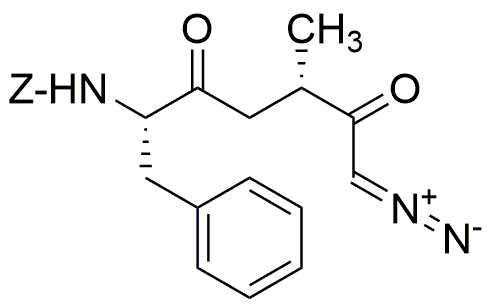Z-Phe-Ala-diazomethylketone is widely utilized in research focused on:
- Peptide Synthesis: This compound serves as a valuable reagent in the synthesis of peptides, enabling researchers to create complex structures for various biological studies.
- Drug Development: It plays a crucial role in medicinal chemistry, particularly in the design and development of new pharmaceuticals targeting specific diseases.
- Bioconjugation: The compound is used in bioconjugation processes, allowing for the attachment of biomolecules to surfaces or other molecules, enhancing drug delivery systems.
- Protein Labeling: Researchers utilize it for labeling proteins, which aids in tracking and studying protein interactions and functions in cellular environments.
- Research in Cancer Therapeutics: Its applications extend to cancer research, where it is used to develop targeted therapies that can selectively attack cancer cells, minimizing damage to healthy tissues.
General Information
Properties
Safety and Regulations
Applications
Z-Phe-Ala-diazomethylketone is widely utilized in research focused on:
- Peptide Synthesis: This compound serves as a valuable reagent in the synthesis of peptides, enabling researchers to create complex structures for various biological studies.
- Drug Development: It plays a crucial role in medicinal chemistry, particularly in the design and development of new pharmaceuticals targeting specific diseases.
- Bioconjugation: The compound is used in bioconjugation processes, allowing for the attachment of biomolecules to surfaces or other molecules, enhancing drug delivery systems.
- Protein Labeling: Researchers utilize it for labeling proteins, which aids in tracking and studying protein interactions and functions in cellular environments.
- Research in Cancer Therapeutics: Its applications extend to cancer research, where it is used to develop targeted therapies that can selectively attack cancer cells, minimizing damage to healthy tissues.
Documents
Safety Data Sheets (SDS)
The SDS provides comprehensive safety information on handling, storage, and disposal of the product.
Product Specification (PS)
The PS provides a comprehensive breakdown of the product’s properties, including chemical composition, physical state, purity, and storage requirements. It also details acceptable quality ranges and the product's intended applications.
Certificates of Analysis (COA)
Search for Certificates of Analysis (COA) by entering the products Lot Number. Lot and Batch Numbers can be found on a product’s label following the words ‘Lot’ or ‘Batch’.
*Catalog Number
*Lot Number
Certificates Of Origin (COO)
This COO confirms the country where the product was manufactured, and also details the materials and components used in it and whether it is derived from natural, synthetic, or other specific sources. This certificate may be required for customs, trade, and regulatory compliance.
*Catalog Number
*Lot Number
Safety Data Sheets (SDS)
The SDS provides comprehensive safety information on handling, storage, and disposal of the product.
DownloadProduct Specification (PS)
The PS provides a comprehensive breakdown of the product’s properties, including chemical composition, physical state, purity, and storage requirements. It also details acceptable quality ranges and the product's intended applications.
DownloadCertificates of Analysis (COA)
Search for Certificates of Analysis (COA) by entering the products Lot Number. Lot and Batch Numbers can be found on a product’s label following the words ‘Lot’ or ‘Batch’.
*Catalog Number
*Lot Number
Certificates Of Origin (COO)
This COO confirms the country where the product was manufactured, and also details the materials and components used in it and whether it is derived from natural, synthetic, or other specific sources. This certificate may be required for customs, trade, and regulatory compliance.


